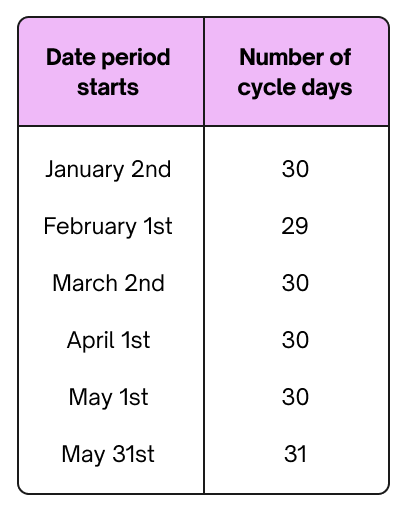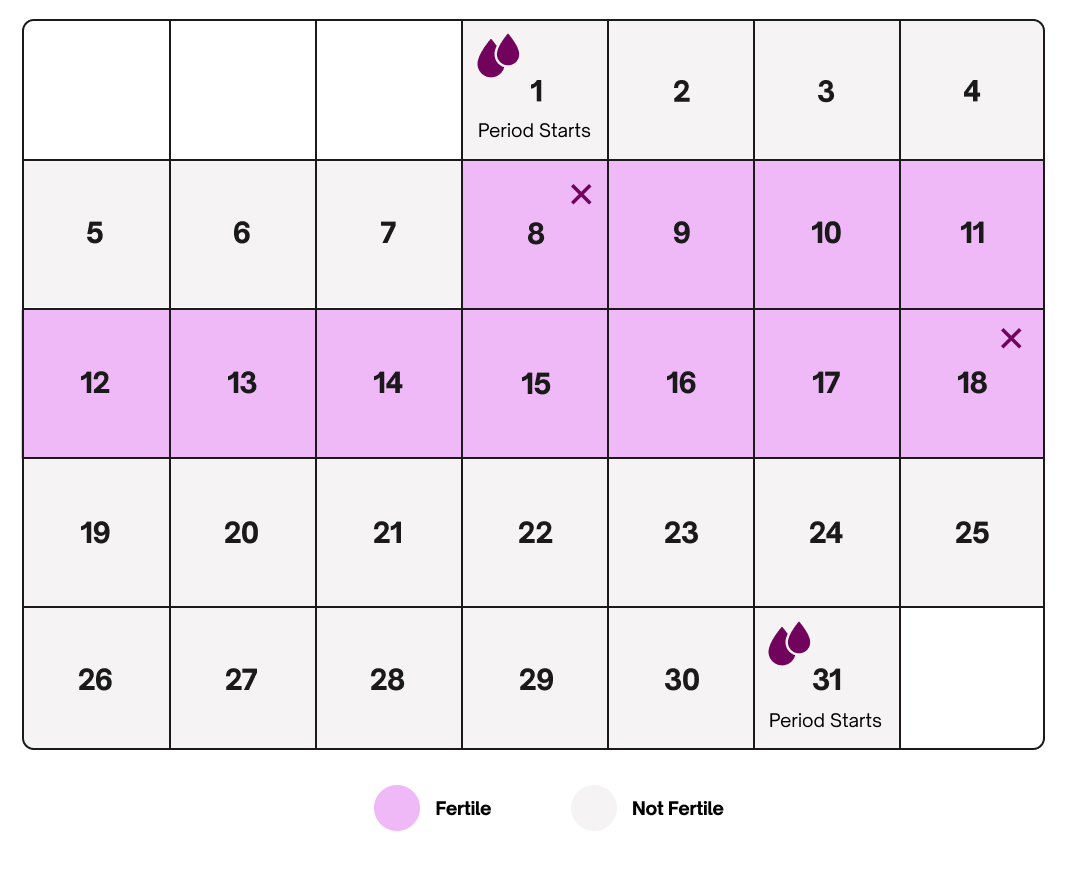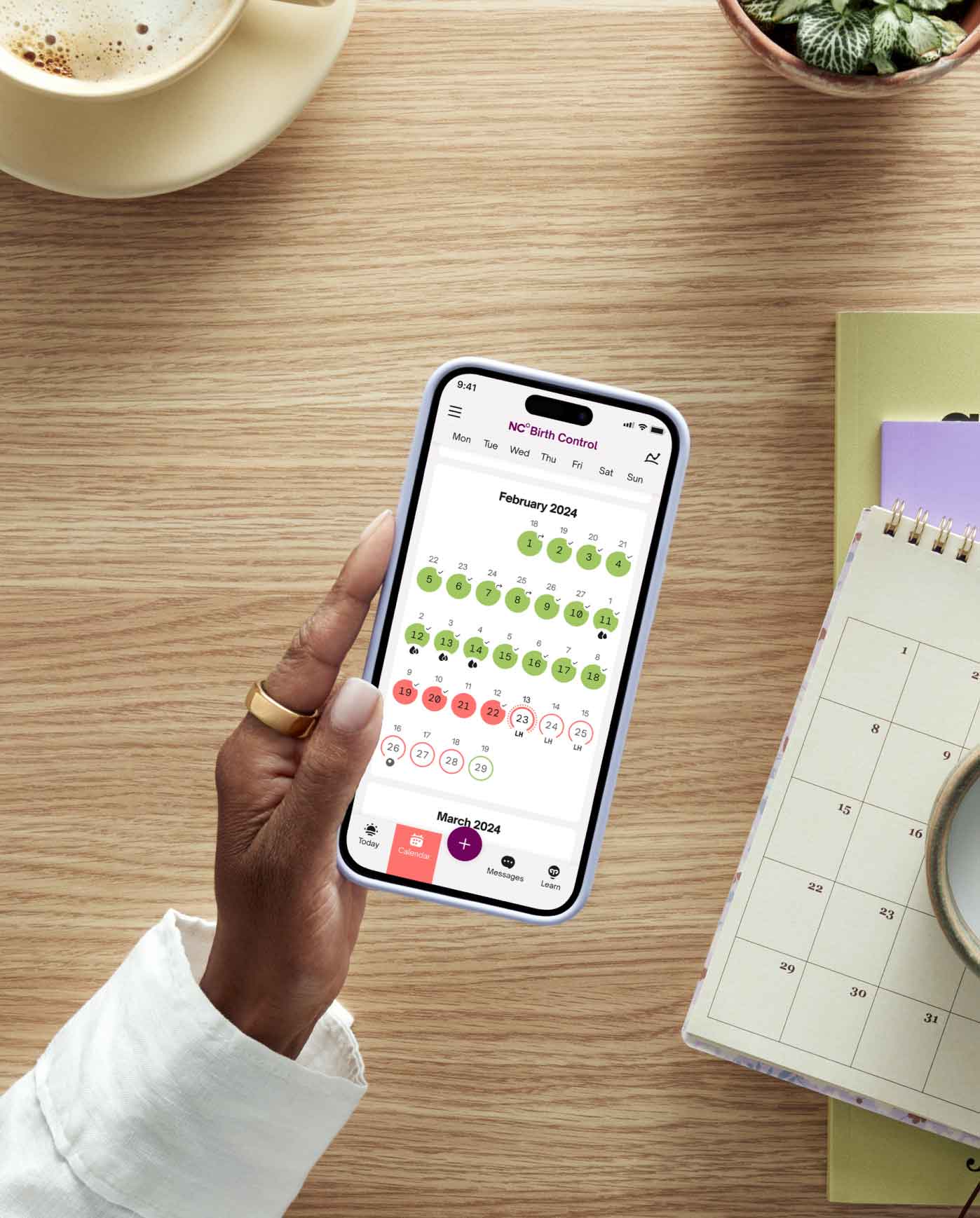Calendar method: Birth control, calendars, and effectiveness
Follows NC° Editorial Policy
Follows NC° Editorial Policy
At Natural Cycles, our mission is to empower you with the knowledge you need to take charge of your health. At Cycle Matters, we create fact-checked, expert-written content that tackles these topics in a compassionate and accessible way. Read more...
Key takeaways:
- Calendar methods are a basic form of fertility awareness that function by counting cycle days to work out the fertile window
- There are multiple types of calendar methods, including the rhythm method and the Standard Days Method
- Calendar methods require a six-month monitoring period and are not suitable for those with irregular cycles
How do I use calendar methods?
Exactly how you use these methods depends on the type of approach you choose. The first step to using calendar methods is to monitor your menstrual cycles and count the days of these for a minimum of six cycles.
Your cycle starts on the first day of your period and ends on the last day before your next period, so it’s important to keep track of period dates. By recording when each cycle starts and ends over the six-month timeframe, you can get a good idea of the regularity of your cycles. Here’s an example of what this might look like:

Once you have this data, you can then do some basic calculations to work out when your fertile days are. On these fertile days, you’ll need to abstain or use barrier protection (such as condoms) to avoid pregnancy.
Let’s take a look at some of the specific types of calendar methods and how they work:
How to use the rhythm method
Once you’ve recorded at least six months of cycle statistics, you will have an idea of your cycle's average length and regularity. With this information, you can do some basic math to estimate which days are predicted to be safe with respect to avoiding pregnancy.
To predict your first fertile day in a cycle:
- Find the shortest cycle out of the ones you have recorded
- Subtract 18 from the total number of days in that cycle
- Count to that number from the first day of your current cycle and mark that day on your calendar (the Xth day of your cycle)
- The day marked X is your first fertile day — you should stop having penetrative vaginal sex on this day (or use a condom) until the last fertile day has passed
To predict the last fertile day in a cycle:
- Find the longest cycle you have recorded
- Subtract 11 from the total number of days in that cycle
- Count to that number from the first day of your period on your current cycle and mark that day with an X
- The day marked X is your last fertile day in the cycle
You’ve now marked out the days when it’s not safe to have sex, according to this method. Here’s an example of what this looks like on a calendar:

Keep in mind that if your cycles are usually shorter than 27 days, you should not use the calendar method as birth control. [1]
How to use the Standard Days Method
The Standard Days Method is a simpler example of a calendar method. Instead of calculating based on your own cycle dates, the Standard Days Method simply allocates cycle days 8 to 19 as fertile days for everyone. [2] Users should abstain from sex or use protection during this window.
Most people following the Standard Days Method will use a cycle tracking app, a calendar, or a string of cycle beads to record where they are in their menstrual cycle each day.
The Standard Days Method is not a suitable option for you if:
- Your cycles are ever shorter than 26 days or longer than 32 days
- Your cycles are irregular or change length frequently
- You’re not comfortable abstaining from sex or using protection from cycle day 8 to 19
What days are safe to have sex when using a calendar method?
This depends. If you’re using the rhythm method for example, you will have to do some calculations to work out your own personal safe days. If you’re using the Standard Days Method, then days before cycle day 8 are safe to have sex, and days after cycle day 19 are considered safe too.
It’s always a good idea to talk to your doctor before switching any type of birth control, but make sure to talk to a healthcare professional before using a calendar method if:
- You recently got your first period
- You’re perimenopausal or are close to menopause
- You’re breastfeeding or just had a baby
- You’ve recently stopped taking birth control pills or other hormonal contraception
- You have irregular menstrual cycles [3]
How effective are calendar methods?
There are limited studies into the effectiveness of the rhythm method specifically, but the Standard Days Method is shown to be 88% effective with typical use and 95% effective with perfect use. [4] The broader category of fertility awareness methods is between 77% and 98% effective, but this includes other more involved methods that track basal body temperature and other fertility indicators such as cervical mucus and don’t rely solely on calendar dates. [1]
Why do people use calendar methods?
Calendar methods can be hard work, and are often less effective than many other types of birth control. However, there are many reasons people choose to use them, including:
- Religious or spiritual reasons: the use of condoms, pills, or other contraceptive methods may go against the guidelines of some religions or spiritual practices.
- A desire for a natural option: For those who can’t take hormonal birth control for medical reasons, or because they suffer from side effects, the calendar method is an alternative.
- Planning pregnancy: As well as being used for contraception, calendar methods can also be used to plan sex during the fertile window in order to conceive.
- Low cost or free: With no prescriptions and little equipment required, calendar methods are one of the most affordable and accessible options out there for many people.
What are the risks and drawbacks of using a calendar method?
As with any form of birth control, it’s important to consider the risks of the calendar method, including:
- Our cycles aren’t like clockwork: Even for those of us who have a regular cycle, there are many things that can delay periods and cause disruption including stress, diet changes, or getting sick. This can affect the accuracy of your calculations and put you at risk of pregnancy.
- They can’t pinpoint ovulation: Calendar methods only provide a rough estimate of the fertile window. Your ovulation day may be different from the average characteristics and could be either earlier or later each cycle. This can put you at risk of unintended pregnancy, or make it harder to get pregnant if you’re trying to conceive.
- Open to human error: Manual counting and calculations leave room for mistakes and take time and effort.
- Monitoring period required: Before you can use a calendar method as contraception you have to wait and record your cycles for at least six months. During this time you will have to abstain from sex or use another hormone-free method of birth control.
- No protection against STIs: Unlike barrier methods such as condoms, calendar methods offer no protection against sexually transmitted infections.
How to make calendar methods more effective
Choosing to monitor your cycles for longer than the required six months can give you a broader picture of your cycle regularity and help you learn more before you start relying on the method as contraception. [1]
You can also incorporate other fertility indicators alongside using a calendar method. The most effective forms of FAMs don’t rely on calendar dates alone: they look at wider fertility signs, such as cervical mucus and basal body temperature. Having a broader picture of your fertility doesn’t just offer another level of protection but it can teach you more about your body too.
Discover Natural Cycles
The world’s first and only FDA Cleared birth control app, Natural Cycles is 100% hormone-free. Using your body temperature data, and other indicators like your period data and optional ovulation tests, Natural Cycles can pinpoint ovulation and determine the fertile window.
The app makes it easy to view your Red (fertile) Days and Green (non-fertile) Days with no manual charting or calculations needed. Here’s an example of a typical calendar view in the NC° app:

When Natural Cycles was compared to calendar methods it was shown to more accurately predict fertile days, and allocate fewer incorrect non-fertile days. [5] With typical use Natural Cycles is 93% effective, with perfect use it’s 98% effective, making it more effective than static calendar methods like the Standard Days Method. [4]
Take control of your cycle and prevent pregnancy naturally
Thanks for reading up on calendar methods! We hope you’ve learned plenty and are closer to finding a solution that will work for you! At Natural Cycles, we understand that when it comes to birth control, it’s important to have a range of options, because everyone’s needs and preferences are different.
We’re proud to offer a certified hormone-free alternative, that’s helped more than 3+ million women worldwide plan or prevent pregnancy. Click ‘get started’ to take our quiz and find out if Natural Cycles could be a good fit for you.
Did you enjoy reading this article?



